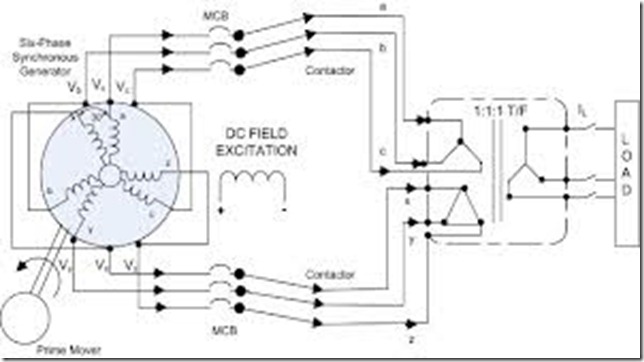The Equation of Electric State for a Phase of a Synchronous Generator
The magnetic field of a loaded synchronous machine is excited not only by the excitation current in the rotor winding, but also by the currents in the phase windings of the stator (armature). This implies that, similarly to d.c. machines, synchronous machine experiences armature reaction, that is, the effect of the armature mmf on the main magnetic field of the machine. The waveform of the emf induced in a phase of a loaded generator depends not only on the distribution of the rotor field around the circumference of the machine, but also on the distribution of the stator field. The latter must likewise be as close to sinusoidal as practicable, so that the resultant field and the emf waveform of the loaded machine could be sinusoidal.
The current in the stator phase windings of a loaded synchronous generator produces voltage drops across the inductive reactance and the resistance of the phase windings. The inductive reactance of a stator phase winding is determined by the leakage flux linkage and the magnetic flux due to the armature reaction.
The inductive leakage reactance of a stator phase winding is determined by the stator leakage flux linkage Ψleak . As is the case with an induction machine, this flux linkage is that part of the overall flux linkage which is due to the magnetic lines of force that have their path outside the rotor, across the slots, at the tips of the teeth, and around the stator coil ends (see Fig 13). The greater proportion of the path traversed by the leakage flux is through air. Therefore it is legitimate to think that the leakage flux linkage is proportional to the stator current and is in phase with it. In the stator phase winding, the leakage flux linkage induces a leakage emf, Eleak , which is in quadrature lagging with the leakage flux linkage. The voltage which balances the leakage emf in terms of the stator current I and the inductive leakage reactance leak , Eq. (2.33)
Ė leak = – jleak İ = – jɷΨ̇leak
At rated load, the voltage drop across leakage inductance in synchronous machines accounts for 10-15% or even 20% of the rated phase voltage. The leakage inductive reactance responsible for this voltage drop serves a useful purpose because it limits the current in the case of a short circuit between the genera tor terminals. The resistance of a stator phase winding is very small. As a rule, given the rated load, the voltage drop across the resistance or a phase winding accounts for 1-2 % of the rated phase voltage in the case of large generators. Therefore it may be neglected in many calculations; we will consider it only in some special cases.
As already noted, the phase emf of a synchronous machine is affected by armature reaction. Physically, only one resultant magnetic field exists in a synchronous machine; it is the sum of the magnetic field due to the rotor, the leakage magnetic field of the stator, and the magnetic field due to armature reaction. it is convenient, however, to consider them as existing independently of one another, producing independent flux linkages with the stator phase windings, and inducing in them the respective emfs, Thus, in a loaded synchronous generator the rotor flux linkage Ψ0 induces in a stator phase winding an emf, E0. equal to the no-load (open-circuit) emf ; the leakage flux linkage Ψleak induces the leakage emf, Eleak and the armature-reaction flux linkage Ψa.r induces an armature-reaction emf, Ea.r, in the stator winding. The simplest relations can be derived on neglecting the effect of hysteresis and core saturation on the armature (stator) flux linkage, that is, on assuming that the armature flux linkage is proportional to the armature current I and is in phase with it. Actually this assumption holds only when the magnetic circuit of a synchronous machine is unsaturated. Under the assumption made, the armature-reaction emf, Ea.r , may be expressed in the same way as the leakage emf Eleak , that is in terms of the armature current I and the armature inductive reactance , arm so that
Ėa.r = – jarm İ = – jɷΨ̇a.r
The term jarm İ is the voltage required to overcome the emf due to armature reaction.
With the above approach, the emf Ė0 induced in a phase winding by the flux linkage Ψ̇0 is equal to the sum of the voltage jleakİ and jleakİ existing across the inductive reactances leak and arm of the phase winding, the voltage rwİ across the resistance of the phase winding conductors, and the terminal phase-winding voltage V̇ .
Hence, the equation of electric state for a phase of a synchronous generator takes the form
Ė0 = V̇ + [rw + j (leak + arm)] İ = V̇ + (rw + j) İ (15.3)
where leak + arm = is the inductive reactance of a stator phase winding, called the synchronous inductive reactance. In a synchronous machine with an unsaturated magnetic circuit it is a relatively constant quantity.

